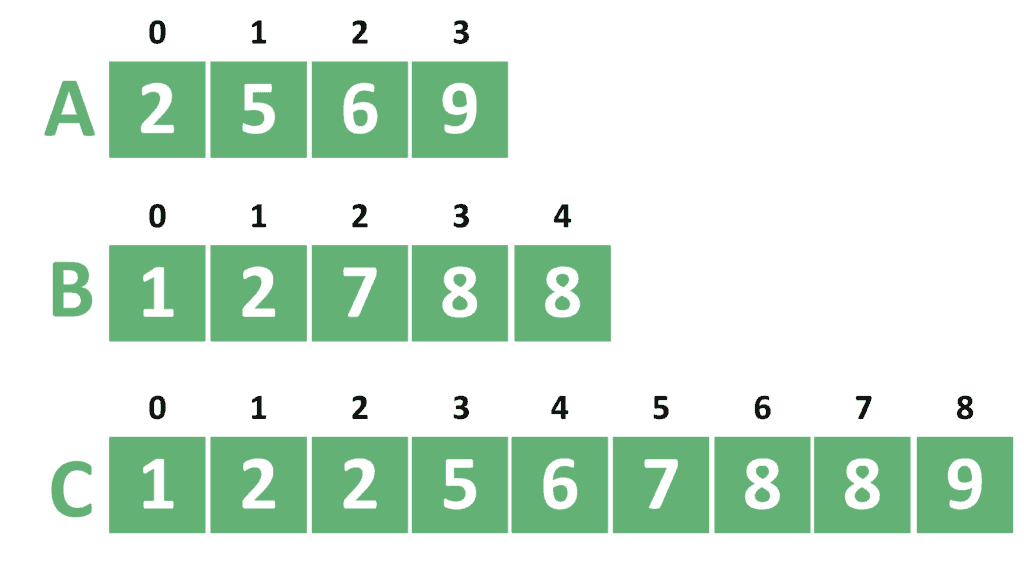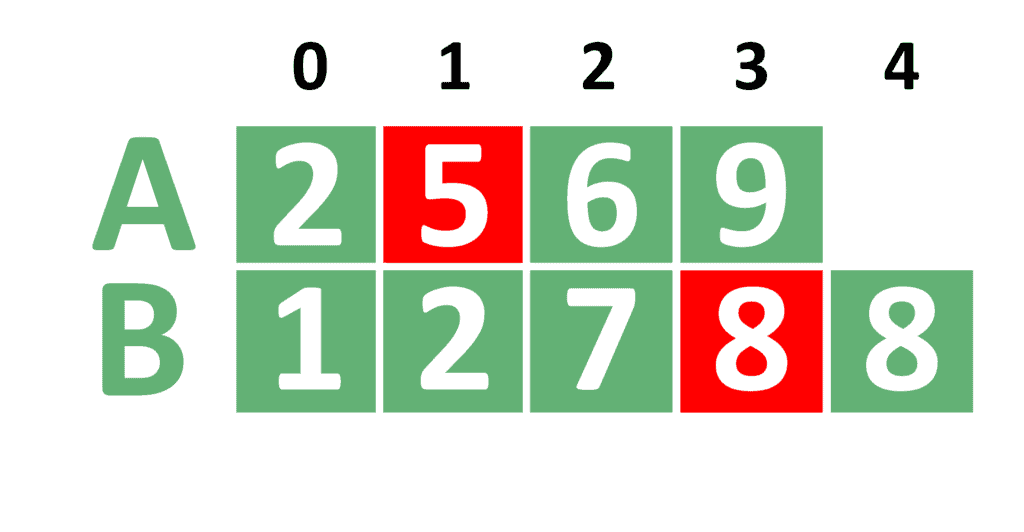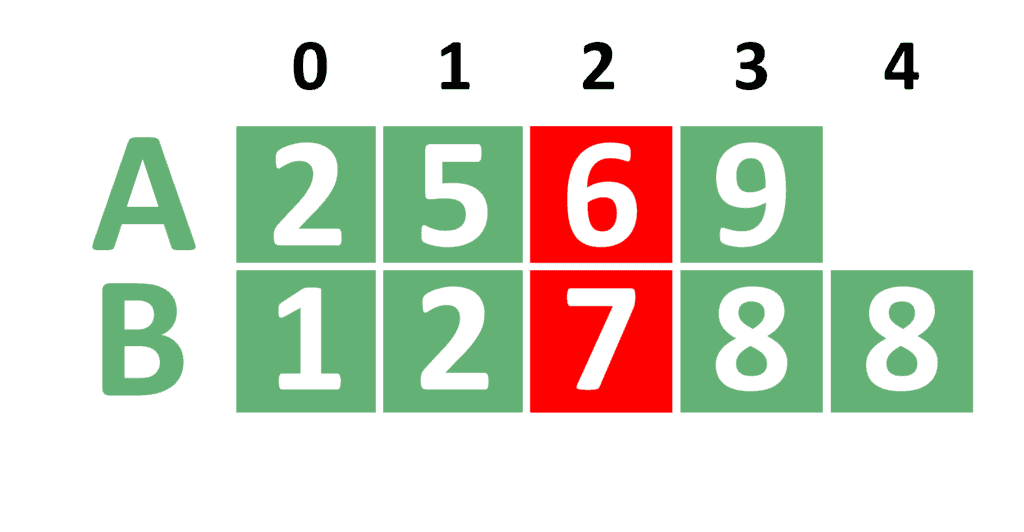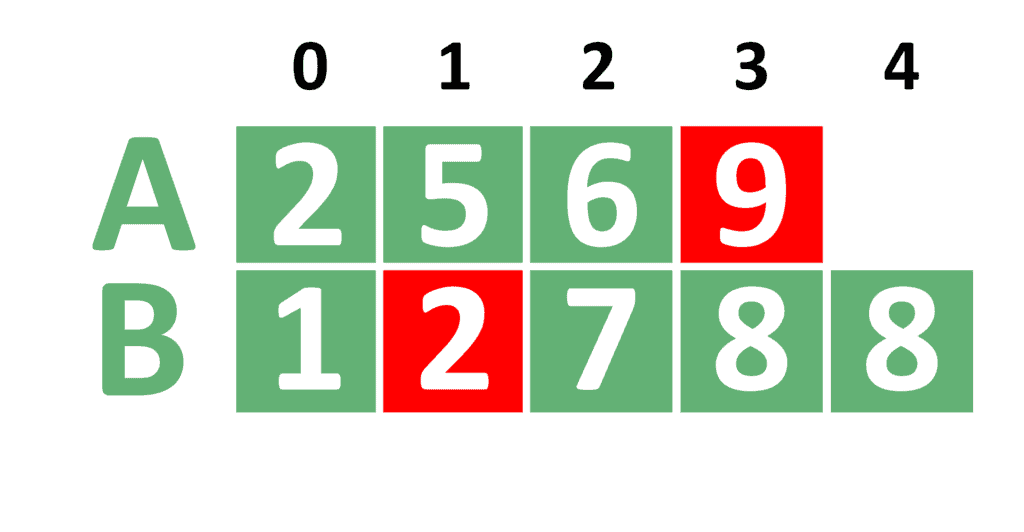1. Overview
In this tutorial, we’ll discuss the problem of finding the kth smallest element in the union of two sorted arrays. We’ll present a naive approach and then improve it.
In the end, we’ll present a comparison between both approaches and when to use them.
Please note that we have a java-based article for this problem. Hence, in this tutorial, we’ll focus more on the theoretical idea and comparison.
2. Defining the Problem
In this problem, we’re given 2 arrays, of size
, and
of size
. Also, the problem will give us an integer
. Both arrays
and
should be sorted in increasing order.
In other words:
for each
for each
We must find the kth smallest element in the sorted union of and
. By the sorted union of
and
, we mean the array
of size
, which contains all the elements of
and
, sorted in the increasing order as well.
Let’s take the following example to better explain the idea:

As we can see, both arrays and
are sorted initially. Similarly, the array
, which is the union of arrays
and
, is sorted as well. Also, we can see that the array
contains all elements from
and
.
Hence, if was equal to 6, then the answer would be 7. The reason is that 7 is at index 5 in the array
(because we start numbering the array from zero).
Another way to look at it is that the number 7 has five numbers smaller than it in both arrays and
. Therefore, it’s the sixth smallest value.
3. Naive Approach
First, we’ll explore the naive approach. Let’s take a look at its implementation:
In the beginning, we set two iterators and
that will show us the current index inside the arrays
and
, respectively.
Now, let’s think about how we’d merge arrays and
. We’d start from the beginning. Each time, we’d add the smallest value to the resulting array. Also, we’d remove the smallest value from its location. Let’s do something similar in this approach.
In each step, we set the answer to the smaller value between and
. In addition, we transfer the iterator who has this smaller value one step forward.
Also, we pay attention to the case when either or
becomes out of the range of their respective arrays. In this case, we move the other iterator. Once we finish walking through
values, we break the while loop.
In the end, we return the stored answer.
The complexity of the naive approach is , where
is the required index. Therefore, in the worst case, the complexity is
, where
is the size of the first array and
is the size of the second one.
4. Binary Search Approach
Let’s try to improve our naive approach.
4.1. General Idea
As we know, the binary search is a searching algorithm that finds the target value within a sorted range. In each step, we divide the range in half.
Next, we check the value in the middle of the range. Based on the result, we either choose the left or the right half of the range to continue our search in. We’ll use something similar here.
In the naive approach, we found the answer by taking elements from
and
elements from
. Based on the same idea, we’ll perform a binary search to find the number of taken elements from the first array
.
In each step, we can calculate the number of taken elements from the second array which is
. After that, we can check whether this combination of
and
is valid or not. Based on the result, we can choose to take either more or fewer elements from
.
4.2. Implementation
Take a look at the binary search approach:
First of all, we’ll choose the range we should search in. Clearly, the right side should equal to .
However, when choosing the left side, the size of the array must be taken into account. Therefore, the left side shouldn’t be less than
, nor less than zero.
Now, we can use the binary search algorithm to find the smallest , such that the biggest value in range
from
is bigger than the biggest value in range
from
. As we can see, we’re taking
elements from
and
elements from
. Therefore, in total, we take
elements.
In each step, we compare the two values we have. If we choose not to take any elements from , or the value of
is larger than
, then we know we reached a valid value of
and store it. We should also try to find a smaller value of
. Therefore, we make the searching range equal to the left one.
Otherwise, it means we should move forward. In this case, we make the searching range equal to the right one.
In the end, we have two cases. Either equals zero, which means we shouldn’t take any elements from
. As a result, the answer will equal to
.
On the other hand, if we should take some elements from , then the kth smallest value is either
or
. The reason is that we know that
is bigger than all elements in the range
.
Therefore, the answer is either itself, or
, whichever is the smallest.
The complexity of the binary search approach is , where
is the size of the first array.
4.3. Example
Let’s take the same example in section 2, where we had two arrays and
, and
was 6. Take a look at the first step in that example:

In the beginning, the searching range is . Hence,
equals 2. Therefore,
equals 2 and
equals 4.
We compare the values of and
. Since
is not greater than
, we try to search on the right range of the array
, without updating the value of
.
Note that, and
represent the number of elements to take from each array. Since indexes start from zero, we compare
with
. Also, note that the cells in red denote the values that are being compared in each step.
Let’s move to the next step:

In the next step, the searching range becomes . From that we conclude that
equals 3,
equals 3 and
equals 3.
We notice that is still not greater than
. Thus, we continue searching on the right range of the array
, without updating the value of
.
This leads us to the last step:

Finally, the searching range is now . This means that
equals 4,
equals 4 and
equals 2. In this case, we notice that
is actually greater than
. As a result, we update the value of
.
The searching range becomes , which is invalid. Therefore, the algorithm doesn’t make any more steps.
Now that the binary search operation is finished, the answer is the minimum between and
. In this case,
is 9 and
is 7. Hence, the algorithm returns 7 as the answer to the problem.
5. Comparison
When considering simplicity, the naive approach is both simpler to implement, and easier to understand. But, when considering the time complexity, the binary search approach generally has a lower complexity.
However, in the special case that is smaller than
, using the naive approach should give us a better complexity.
6. Conclusion
In this tutorial, we explained the problem of calculating the Kth smallest element in the union of two sorted arrays. Firstly, we presented the naive approach.
Secondly, we discussed the theoretical idea and the implementation of the binary search approach.
Finally, we presented a summary comparison between both approaches and showed when to use each one.